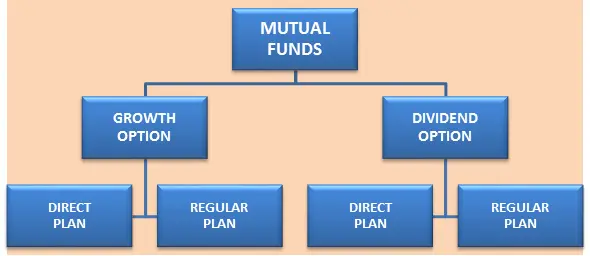
Table of Content
If you open the fund fact sheet of any equity or debt mutual fund, you will find a clear segregation between Regular Plans and Direct Plans. Let us understand this distinction first.
Direct Plans of any fund have a net asset value (NAV) that is higher than the NAV of a Regular Plan. But, what is NAV?
NAV = (Market Value of Assets – Cost Debits) / Number of units outstanding
In case of an equity fund, the market value of all the stocks is aggregated to get the overall market value. How does the fund decide on the debits? Typically, every fund charges the Total Expense Ratio (TER) as a percentage of the total AUM. For example, if the total corpus of the fund is Rs3,000 cr and the TER is 2.5%, then the total annual cost of Rs75 cr will be proportionately debited to the NAV on a daily basis. When you are having a Direct Plan, your value of assets is the same, but due to a lower TER, the eventual NAV tends to be higher.

Here are how regular plans differ from Direct Plans:
Regular Plans charge all costs including selling costs, distributor commissions and trail commissions as part of the TER to the fund holder. In case of Direct Plans, all costs other than the distribution costs and the trail costs are charged. Thus the TER of the Direct Plan is lower.
Regular plans can be relatively more convenient. The relationship manager (RM) will collect the form and also ensure that it is submitted at the registrar office and you get the units credited. When you opt for a Direct Plan, it is you who normally has to handle all these procedural aspects.
Regular Plans provide you the additional benefit of advisory services and inputs to restructure your mutual fund portfolio based on shifting market conditions. In case of Direct Plans you don’t have an advisory support from the broker. Of course, you can choose to pay an independent financial advisor separately for the service.
Direct plans will surely help you to get better NAV value as the costs are lower. However, like in the case of discount broking, you need to make a trade-off between reduced costs and availability of advisory support.
To understand the impact of the lower TER, let us take the case of two plans of the same fund; Regular Plan and the Direct Plan. The initial NAV is assumed to be Rs100 and the TER of the Direct Plan is 1.80% as against the Regular Plan TER of 2.45%. Let us look at two different scenarios of returns and see how the lower TER impacts returns.
Scenario 1: CAGR Returns of 15%
| CAGR Ret | 15% | REG TER | 2.45% | DIR TER | 1.80% | ||
|---|---|---|---|---|---|---|---|
| Regular Plan | Direct Plan | ||||||
| NAV | Post TER Yield | Net NAV | NAV | Post TER Yield | Net NAV | ||
| Year 0 | 100.00 | 12.55% | 112.55 | 100.00 | 13.20% | 113.20 | |
| Year 1 | 112.55 | 12.55% | 126.68 | 113.20 | 13.20% | 128.14 | |
| Year 2 | 126.68 | 12.55% | 142.57 | 128.14 | 13.20% | 145.06 | |
| Year 3 | 142.57 | 12.55% | 160.47 | 145.06 | 13.20% | 164.20 | |
| Year 4 | 160.47 | 12.55% | 180.60 | 164.20 | 13.20% | 185.88 | |
| Year 5 | 180.60 | 12.55% | 203.27 | 185.88 | 13.20% | 210.42 | |
| Direct Plan Wealth Advantage | 3.52% |
Scenario 2: CAGR Returns of 5%
| CAGR Ret | 5% | REG TER | 2.45% | DIR TER | 1.80% | ||
| Regular Plan | Direct Plan | ||||||
| NAV | Post TER Yield | Net NAV | NAV | Post TER Yield | Net NAV | ||
| Year 0 | 100.00 | 2.55% | 102.55 | 100.00 | 3.20% | 103.20 | |
| Year 1 | 102.55 | 2.55% | 105.17 | 103.20 | 3.20% | 106.50 | |
| Year 2 | 105.17 | 2.55% | 107.85 | 106.50 | 3.20% | 109.91 | |
| Year 3 | 107.85 | 2.55% | 110.60 | 109.91 | 3.20% | 113.43 | |
| Year 4 | 110.60 | 2.55% | 113.42 | 113.43 | 3.20% | 117.06 | |
| Year 5 | 113.42 | 2.55% | 116.31 | 117.06 | 3.20% | 120.80 | |
| Direct Plan Wealth Advantage | 3.86% |
An interesting point emerges here. When the CAGR returns are lower the Direct Plan looks a lot better in terms of the return advantage. As John Bogle of Vanguard put it, it is only when the going is tough that you realize the virtue of pinching on costs. The choice is yours!
Invest wise with Expert advice
![]() IIFL Customer Care Number
IIFL Customer Care Number
(Gold/NCD/NBFC/Insurance/NPS)
1860-267-3000 / 7039-050-000
![]() IIFL Capital Services Support WhatsApp Number
IIFL Capital Services Support WhatsApp Number
+91 9892691696
IIFL Securities Limited - Stock Broker SEBI Regn. No: INZ000164132, PMS SEBI Regn. No: INP000002213,IA SEBI Regn. No: INA000000623, SEBI RA Regn. No: INH000000248
ARN NO : 47791 (AMFI Registered Mutual Fund Distributor)

This Certificate Demonstrates That IIFL As An Organization Has Defined And Put In Place Best-Practice Information Security Processes.